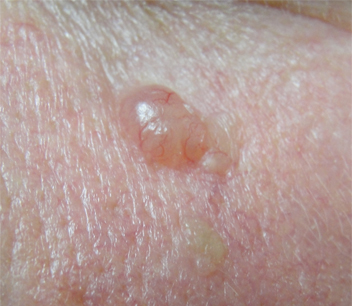History and exam
Key diagnostic factors
common
papules with associated telangiectasias
Other diagnostic factors
uncommon
metastases associated with large or neglected BCC
Metastases are uncommon, but may occur in the lungs and bones, typically in association with a large longstanding neglected basal cell carcinoma (BCC).[11]
local destruction with advanced lesion
Several centimeters in diameter and deeply eroding into the surrounding tissue.
Risk factors
strong
Ultraviolet (UV) radiation
UV radiation induces DNA damage in keratinocytes. Damage to p53, a pro-apoptotic molecule, leads to resistance of the DNA-damaged cell to apoptosis.
It is believed that 290-320 nanometer wavelength UV-B (commonly referred to as sunburn wavelength) plays a greater role in the formation of basal cell carcinoma than 320-400 nanometer wavelength (so-called tanning wavelength) UV-A radiation.[18]
sun exposure
x-ray exposure
arsenic exposure
aberrant hedgehog signaling pathway
xeroderma pigmentosum
An inborn error of DNA-repair mechanisms that predisposes patients to develop early skin aging, innumerable basal cell carcinomas, squamous cell carcinomas, and melanoma.[31]
nevoid basal cell carcinoma (Gorlin-Goltz) syndrome
An uncommon autosomal dominant condition caused by a mutation of PTCH1.[32] It may first be evident with a broad face, rib deformities, and possibly central nervous system abnormalities. It may also present with palmoplantar pits and odontogenic keratocysts. Other clinical manifestations include osteosarcoma, medulloblastoma, and ovarian fibroma.[33]
Although it was believed that initially patients presented with nevi (hamartomas) of the skin, it is evident that these are trichoepitheliomas or trichoblastomas that progress into infundibulocystic and other types of basal cell carcinoma.[34][35][36][37][38]
history of nonmelanona skin cancer
A history of basal cell carcinoma (BCC) or squamous cell carcinoma is the most common predisposing factor for the development of BCC.[6]
childhood cancer survivors
One retrospective cohort study reported that the risk for basal cell carcinoma (BCC) in childhood survivors who received radiation therapy is 30 times greater than expected in the general population; multiple BCCs occurred in 47% of BCC patients, with 13% having 10 or more BCCs.[39]
The greatest risks for BCCs were observed when radiation therapy was combined with chemotherapy, when radiation therapy occurred in patients younger than 5 years, and in the areas receiving radiation, mostly in the head and neck.[39]
Use of this content is subject to our disclaimer
